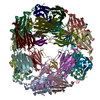+Search query
-Structure paper
| Title | Cryo-EM structure of a 16.5-kDa small heat-shock protein from Methanocaldococcus jannaschii. |
|---|---|
| Journal, issue, pages | Int J Biol Macromol, Vol. 258, Issue Pt 1, Page 128763, Year 2024 |
| Publish date | Dec 15, 2023 |
 Authors Authors | Joohyun Lee / Bumhan Ryu / Truc Kim / Kyeong Kyu Kim /  |
| PubMed Abstract | The small heat-shock protein (sHSP) from the archaea Methanocaldococcus jannaschii, MjsHSP16.5, functions as a broad substrate ATP-independent holding chaperone protecting misfolded proteins from ...The small heat-shock protein (sHSP) from the archaea Methanocaldococcus jannaschii, MjsHSP16.5, functions as a broad substrate ATP-independent holding chaperone protecting misfolded proteins from aggregation under stress conditions. This protein is the first sHSP characterized by X-ray crystallography, thereby contributing significantly to our understanding of sHSPs. However, despite numerous studies assessing its functions and structures, the precise arrangement of the N-terminal domains (NTDs) within this sHSP cage remains elusive. Here we present the cryo-electron microscopy (cryo-EM) structure of MjsHSP16.5 at 2.49-Å resolution. The subunits of MjsHSP16.5 in the cryo-EM structure exhibit lesser compaction compared to their counterparts in the crystal structure. This structural feature holds particular significance in relation to the biophysical properties of MjsHSP16.5, suggesting a close resemblance to this sHSP native state. Additionally, our cryo-EM structure unveils the density of residues 24-33 within the NTD of MjsHSP16.5, a feature that typically remains invisible in the majority of its crystal structures. Notably, these residues show a propensity to adopt a β-strand conformation and engage in antiparallel interactions with strand β1, both intra- and inter-subunit modes. These structural insights are corroborated by structural predictions, disulfide bond cross-linking studies of Cys-substitution mutants, and protein disaggregation assays. A comprehensive understanding of the structural features of MjsHSP16.5 expectedly holds the potential to inspire a wide range of interdisciplinary applications, owing to the renowned versatility of this sHSP as a nanoscale protein platform. |
 External links External links |  Int J Biol Macromol / Int J Biol Macromol /  PubMed:38103675 PubMed:38103675 |
| Methods | EM (single particle) |
| Resolution | 2.49 - 3.02 Å |
| Structure data |  EMDB-37712: Small-heat shock protein from Methanocaldococcus jannaschii, Hsp16.5 EMDB-37713, PDB-8wp9: |
| Source |
|
 Keywords Keywords |  CHAPERONE / Hsp16.5; molecular chaperone; oligomeric protein; small heat-shock protein; stress response CHAPERONE / Hsp16.5; molecular chaperone; oligomeric protein; small heat-shock protein; stress response |
 Movie
Movie Controller
Controller Structure viewers
Structure viewers About Yorodumi Papers
About Yorodumi Papers







